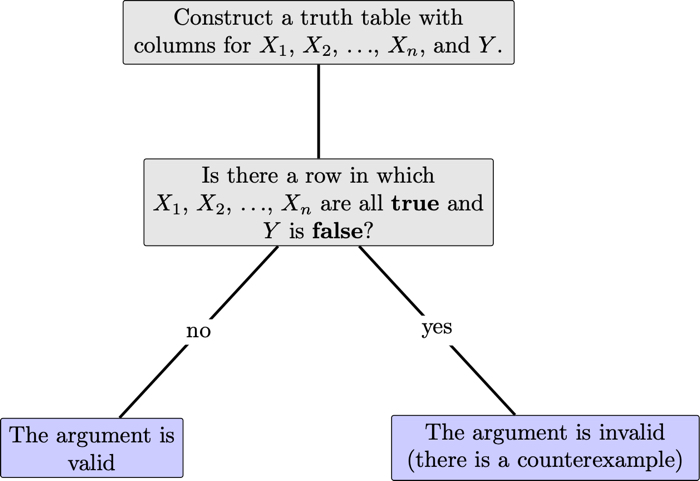Validity
Consider a truth table for the formulas , and .
| 1. | |||||
| 2. | |||||
| 3. | |||||
| 4. |
A couple observations about this truth table:
- Each pair of formulas are satisfiable: and are both true in row 3; and are both true in row 2; and and are both true in row 4.
- There is no row in which all three formulas are true: The only row in which and are true is row 3, but is false in this row. When this happens, we say that the set of formulas is not satisfiable.
- In every row in which and are true, is true: The only row in which and are true is row 3, and in this row is true.
- In every row in which is false, at least one of or is false. The two rows in which is false is 2 and 4. In row 2, is false and in row 4 is false.
The last two observations explain why the argument with premises and and conclusion is valid.
Recall (see the section on argument form) that we denote an inference, or argument, by listing the premises separated a comma followed by '' followed by the conclusion. For instance, the argument with premises and and conclusion is written as:
The truth table given above shows that this argument is valid, where validity of an argument is defined as follows.
An argument, or inference, is valid if there is no truth value assignment that makes each true and false.
We write when is valid.
We write when is not valid.
: That is, is valid. To see this, we first construct a truth table with a column for :
| 1. | |||
| 2. | |||
| 3. | |||
| 4. |
The second step is to verify that there is no truth value assignment that makes each of and true and false. Recall that each row of the truth table is a truth value assignment, and the above truth table lists all the relevant truth value assignments to determine the validity of the argument. We can explain why the argument is valid in two ways:
Row 1 is the only row in which and is true, and in that row is true. This means that there is no row in which and are both true and is false. So, the argument is valid.
is false in rows 2 and 4. In row 2, is false, and in row 4, is false. This means that every row in which is false, at least one of the premises is false. That is, there is no row in which and are both true and is false. So, the argument is valid.
: That is, is not valid. To see this, we first construct a truth table with a column for :
| 1. | |||
| 2. | |||
| 3. | |||
| 4. |
The second step is to verify that there is a truth value assignment that makes and both true and false. In row 3, and is true and is false. This means that there is a truth value assignment that makes and both true and false. This means that the argument is not valid.
The following picture summarizes the procedure to determine whether an argument is valid.

The following are equivalent ways to define validity of an argument:
- There is no truth value assignment that makes all the premises true and the conclusion false.
- Every truth value assignment that makes all the premises true also makes the conclusion true.
- Every truth value assignment that makes the conclusion false also makes at least one of the premises false.
Practice Questions#
I. Answer the following true/false questions.
- True or False: If an argument has a false conclusion, then it is invalid.
True or False: If the conclusion of a valid argument is false, then at least one of its premises is false.
True or False: Adding a premise to a valid argument may make the argument invalid.
True or False: If an argument has a contradiction as a premise, then the argument is valid.
True or False: If an argument has a tautology as a conclusion, then the argument is valid.
True or False: If there is some truth value assignment that makes all the premises and the conclusion are true, then the argument is valid.
True or False: If an argument has premises that are not satisfiable, then the argument is valid.
II. Use a truth table to determine whether the argument is valid.